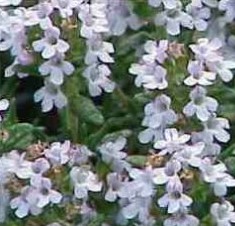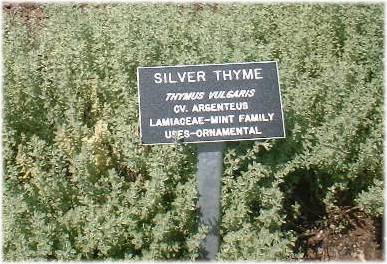|
Additional
Thyme Information
Medicinal Uses
Recipes
Magic & Superstition
Herb Index Page
Site Map
Home
Annuals
Architectural Elements
Backyard
Habitat
Biennials
Bonsai
Bulbs
Cactus/Xeriscaping
Companions
Composting
Container
Gardening
Crafts
Gardening Q/A
Garden Ornamentation
Gargoyles
Greenhouses
Ground Covers
Herbs
Houseplants
Insects/Diseases
Landscaping
Organics
Perennials
Ponds
Propagation
Recipes
Roses
Seeds
Shade Gardens
Shrubs/Hedges
Tools
Trees
Vegetables
Vines
Weeds
Wildflowers
Wildlife
Shop Gardening
|
 Thyme is one of
the great culinary herbs, and the old saying..."When in doubt, use thyme"
certainly still applies today. Thyme blends well with dozens of foods,
and there are varieties that mimic other herbs almost exactly when used in
cooking. Thyme is very nearly the perfect useful culinary herb. Thyme is one of
the great culinary herbs, and the old saying..."When in doubt, use thyme"
certainly still applies today. Thyme blends well with dozens of foods,
and there are varieties that mimic other herbs almost exactly when used in
cooking. Thyme is very nearly the perfect useful culinary herb.
Thyme is a perennial herb that is basically a small, many-branched, aromatic
shrub (6-12 inches in height). It has small lilac to pink flowers in
June and July. It is native to the western Mediterranean region but
is cultivated widely. It has a green taste with something of a clove
aftertaste. It blends well with lemon, garlic, and basil, and is used
as a garnish in salads and chowders. It can be used with just about
any meat, casserole, stew, soup, or vegetable dish.
Thyme is an easy plant to grow, and will do well in sun or partial
shade. Make sure the site is well-drained, as Thyme does not like wet feet.
Bees are attracted to the flowers, and as such, Thyme is a good addition
to a
Habitat type of gardening scheme. The smaller varieties can
be grown between brick pavers on pathways so the delicious scent can be smelled
while walking over them. Thyme is a wonderful container plant, cascading
beautifully over the sides of its container, and it is also an excellent rock
garden addition due to its cascading habit.
Propagate Thyme by seed, root division,
or cuttings. For cuttings, use newer growth and not the older, woody
stems. Simply cut a stem of 3 inches or so and place in moist soil.
Roots should form within a week, give or take a few days. If planting
from seed, the seedlings should appear within 1-2 weeks. Keep moist
until seedlings are established, and then place in the garden.
Once in the garden, pay attention to watering for about a month until the
plants send out a root system, but after that, Thyme will do well on its own
with very little attention from you.
Thyme is a must for any herb garden, flower
garden, or difficult corner of the yard that could use a short, nice-looking,
useful plant. Thyme also makes an excellent companion plant for other herbs
and vegetables. Please see
Companion Planting
for more information.

|

|
 Thyme is one of
the great culinary herbs, and the old saying..."When in doubt, use thyme"
certainly still applies today. Thyme blends well with dozens of foods,
and there are varieties that mimic other herbs almost exactly when used in
cooking. Thyme is very nearly the perfect useful culinary herb.
Thyme is one of
the great culinary herbs, and the old saying..."When in doubt, use thyme"
certainly still applies today. Thyme blends well with dozens of foods,
and there are varieties that mimic other herbs almost exactly when used in
cooking. Thyme is very nearly the perfect useful culinary herb.